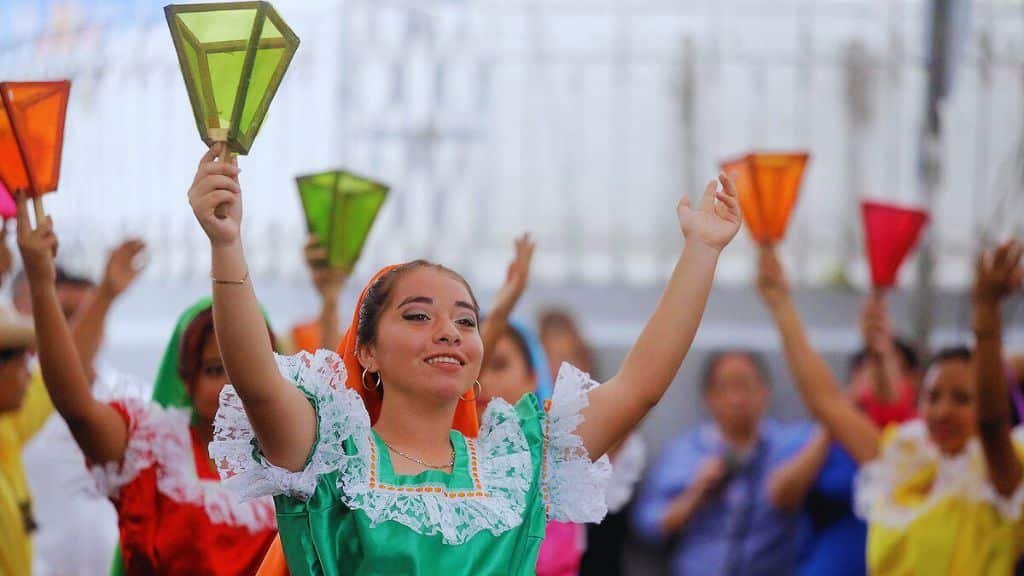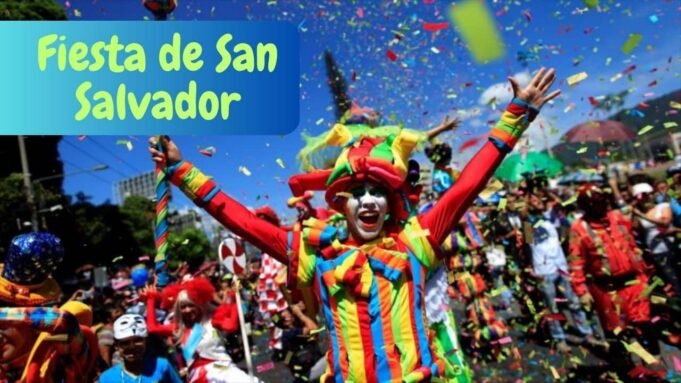Fiesta de San Salvador is a national holiday in El Salvador celebrated every year on August 6. This deeply rooted religious and cultural event honors Jesus Christ as the Divine Savior of the World, the patron of both the country and its capital, San Salvador.
The celebration marks the Feast of the Transfiguration, where Christ’s appearance changed to reflect His divine nature. The festival blends Catholic traditions with local customs and includes parades, religious ceremonies, and traditional food.
One of the most significant moments is “La Bajada,” a symbolic descent of Christ’s statue through the streets of San Salvador. In this article, I will share the full history, traditions, meanings, and frequently asked questions about Fiesta de San Salvador.
When Is Fiesta de San Salvador Celebrated in 2025?
Fiesta de San Salvador will be celebrated on Wednesday, August 6, 2025. This national holiday marks the Feast of the Transfiguration of Jesus Christ, who is honored in El Salvador as El Divino Salvador del Mundo (the Divine Savior of the World). Although August 6 is the official date, celebrations in San Salvador begin several days earlier, including municipal holidays in the capital.
Events typically span from August 1 to August 6, culminating in a large-scale procession known as La Bajada. The festival is both religious and patriotic, uniting families, churches, and local communities in celebration. Across the country, schools, businesses, and government offices close in observance of this meaningful day.
What Is the History of Fiesta de San Salvador?
The history of the Fiesta de San Salvador begins in the 16th century, when Spanish Conquistador Pedro de Alvarado named the region after Jesus Christ. The original name, Provincia De Nuestro Señor Jesucristo, El Salvador Del Mundo, meaning “Province of our Lord Jesus Christ, the Savior of the World,” was eventually shortened to El Salvador. The capital was named San Salvador, or “Holy Savior,” further emphasizing the region’s spiritual identity.
As part of the Spanish tradition of Fiestas Patronales, each city honored a patron saint with an annual celebration. For San Salvador, the patron is Jesus Christ, and rather than celebrate His birth or death (already recognized as Christmas and Easter), the city chose the Feast of the Transfiguration. This event became a national holiday, blending religious devotion with cultural pride.
Related: Respect for Parents Day
What Does the Transfiguration of Christ Represent in the Festival?
The Transfiguration of Christ is central to the meaning of Fiesta de San Salvador. It refers to a biblical event where Jesus’s appearance changed before His disciples — His face shone like the sun, and His clothing became white as light. This moment, described in the New Testament, symbolized His divine nature. In El Salvador, the celebration connects this transformation to national identity and spiritual faith.
During the festival, this moment is reenacted symbolically when a wooden statue of Jesus dressed in purple descends in a public procession and reappears dressed in white. This act, known as La Bajada, visually represents the Transfiguration and serves as a powerful reminder of both Christ’s divinity and His role as the spiritual protector of the Salvadoran people.
What Is La Bajada and Why Is It Important?
La Bajada, meaning “the descent,” is the most significant event during Fiesta de San Salvador. It takes place on August 5, the day before the main holiday, in the streets of San Salvador. The ritual features a large public procession where a wooden statue of Jesus Christ, dressed in purple, is carried through the city. The parade ends in front of the Metropolitan Cathedral, where the statue is placed inside a symbolic globe or chalice.
Moments later, it re-emerges dressed in white garments, representing the Transfiguration of Christ. This powerful transformation symbolizes spiritual renewal, light over darkness, and divine presence. Thousands gather to witness La Bajada, which serves as a national expression of faith and unity for Salvadorans.
Read More: National Frozen Custard Day
How Is Fiesta de San Salvador Celebrated in San Salvador Today?
In modern-day San Salvador, the Fiesta de San Salvador is a vibrant mix of religious tradition and community celebration. The festivities begin with El Correo, a costumed parade featuring music, street performances, and dancers dressed as folk characters. Leading up to August 6, the city hosts fairs, artisan markets, and cultural exhibitions. Churches hold masses and prayer services, while public spaces come alive with flags, banners, and patriotic symbols.
On the night of August 5, La Bajada takes place, followed by fireworks and live performances. Families gather for traditional meals, and local vendors offer Salvadoran food like pupusas and yuca frita. The celebration reflects a deep connection between faith, national identity, and cultural pride.
What Are Some Traditional Fiesta de San Salvador Activities?

Traditional activities during Fiesta de San Salvador reflect both religious devotion and cultural heritage. Some of the most popular include:
- Religious Processions – including La Bajada and special church services honoring the Divine Savior.
- El Correo Parade – Participants dress as folkloric characters, accompanied by music and dancing.
- Local Fairs – Featuring artisan crafts, traditional foods, and games for families.
- Community Gatherings – Families and neighbors join in neighborhood celebrations and shared meals.
- Bolas de Fuego (Balls of Fire) – In nearby Nejapa, this unique tradition involves people throwing flaming balls, symbolizing a legendary volcanic battle tied to Saint Jerome.
These activities are not just entertainment — they are expressions of Salvadoran identity and Catholic faith passed down through generations.
Read More: National Raspberry Cream Pie Day 2025
How Do People Celebrate Fiesta de San Salvador at Home or Abroad?
Salvadorans celebrate the Fiesta de San Salvador both in their homeland and across the world. In San Salvador, families participate in public processions, attend church services, and take part in city-wide events. At home, many prepare traditional meals, decorate with national colors, and gather for prayer.
Outside El Salvador, especially in areas with large Salvadoran communities like the United States, people organize cultural events in churches and community centers. These include mass services, food festivals, and reenactments of La Bajada. For many abroad, the holiday is a way to stay connected to their roots, honor their faith, and pass down Salvadoran traditions to younger generations.
What Foods Are Popular During Fiesta de San Salvador?
Traditional Salvadoran cuisine plays a central role in the Fiesta de San Salvador. Common dishes include:
- Pupusas – Thick corn tortillas stuffed with cheese, beans, or pork, served with curtido (pickled cabbage).
- Yuca Frita – Fried cassava root, often paired with chicharrón (fried pork).
- Tamales – Corn dough filled with meat or vegetables, wrapped in banana leaves.
- Empanadas – Fried pastries usually filled with beans or sweet cream.
- Quesadilla Salvadoreña – A sweet cheese bread popular during festive seasons.
These foods are often served at home gatherings, community celebrations, and street fairs. Food is more than sustenance during the holiday — it is a key expression of cultural pride and hospitality.
Read Also: Kadooment Day 2025
Fiesta de San Salvador Dates (2025–2030)
Fiesta de San Salvador is celebrated annually on August 6, with the main events centered around the capital city. Below is a table listing the upcoming dates and days of the week:
| Year | Date | Day |
| 2025 | August 6 | Wednesday |
| 2026 | August 6 | Thursday |
| 2027 | August 6 | Friday |
| 2028 | August 6 | Sunday |
| 2029 | August 6 | Monday |
| 2030 | August 6 | Tuesday |
5 Interesting Facts About Fiesta de San Salvador and El Salvador
- The Festival Honors Jesus, Not a Saint
Unlike other Fiestas Patronales, San Salvador celebrates Jesus Christ as its patron — a unique distinction in the region.
- The Name ‘El Salvador’ Means ‘The Savior’
The country’s full colonial name was El Salvador del Mundo, directly tying its identity to Jesus.
- The Statue’s Transformation Is a Live Reenactment
La Bajada reenacts the Transfiguration with a physical statue changing from purple to white garments.
- El Salvador Is Known as the Land of Volcanoes
With over 20 volcanoes, the country has a landscape shaped by dramatic natural forces.
- San Salvador’s Festival Has Global Reach
The celebration now includes international observances in Salvadoran diaspora communities.
Read Also: National White Wine Day
Frequently Asked Questions (FAQs) About Fiesta de San Salvador
Curious about the traditions behind El Salvador’s most vibrant celebration? This FAQ section answers common questions about Fiesta de San Salvador, from its religious roots to the colorful events and customs.
Is Fiesta de San Salvador a public holiday?
Yes, Fiesta de San Salvador is a national public holiday in El Salvador. Government offices, schools, and many businesses close nationwide.
What is the meaning of ‘Divino Salvador del Mundo’?
It translates to “Divine Savior of the World” and refers to Jesus Christ, who is honored as the patron of both the country and the capital.
What happens during La Bajada?
A statue of Jesus dressed in purple is carried through the streets and later transformed into white garments, symbolizing the Transfiguration.
Where does the main celebration take place?
The heart of the celebration is in San Salvador, especially near the Metropolitan Cathedral.
Do Salvadorans abroad celebrate this day?
Yes. Salvadorans living in countries like the U.S. and Canada often organize church services, cultural events, and family gatherings.
Conclusion
Fiesta de San Salvador is more than a national holiday — it is a powerful reflection of faith, heritage, and unity for the people of El Salvador. Celebrated every year on August 6, the event honors Jesus Christ as the Divine Savior of the World, the figure after whom the country is named.
Through meaningful traditions like La Bajada, vibrant parades, and shared meals, Salvadorans at home and abroad continue to preserve their identity and values. Fiesta de San Salvador serves as a reminder of both religious devotion and national pride, keeping centuries-old customs alive for generations to come.
















[…] Read Also: Fiesta de San Salvador in El Salvador […]
Comments are closed.